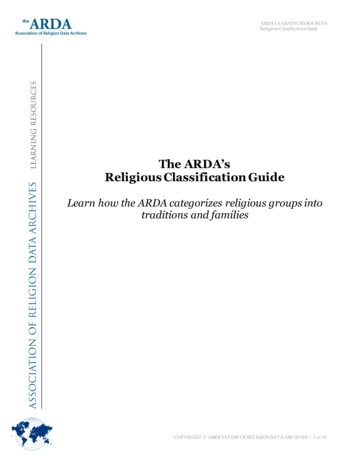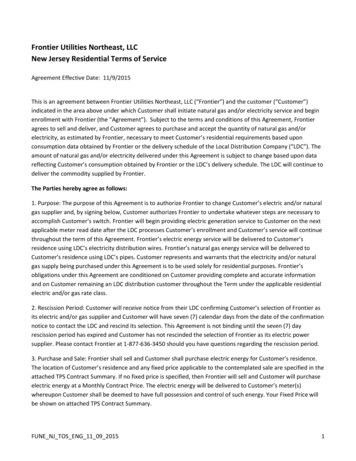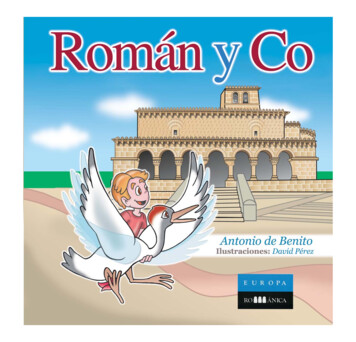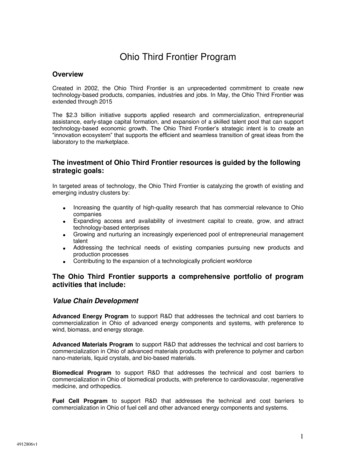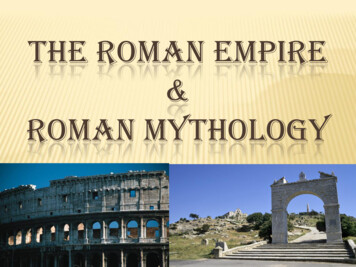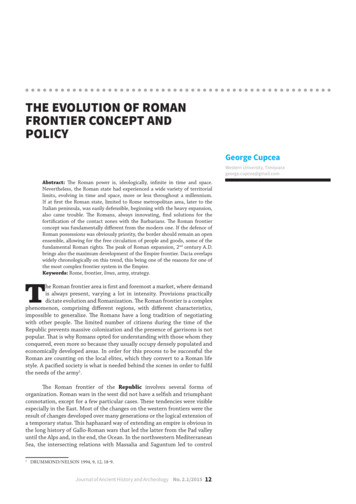
Transcription
THE EVOLUTION OF ROMANFRONTIER CONCEPT ANDPOLICYGeorge CupceaWestern University, Timișoarageorge.cupcea@gmail.comAbstract: The Roman power is, ideologically, infinite in time and space.Nevertheless, the Roman state had experienced a wide variety of territoriallimits, evolving in time and space, more or less throughout a millennium.If at first the Roman state, limited to Rome metropolitan area, later to theItalian peninsula, was easily defensible, beginning with the heavy expansion,also came trouble. The Romans, always innovating, find solutions for thefortification of the contact zones with the Barbarians. The Roman frontierconcept was fundamentally different from the modern one. If the defence ofRoman possessions was obviously priority, the border should remain an openensemble, allowing for the free circulation of people and goods, some of thefundamental Roman rights. The peak of Roman expansion, 2nd century A.D.brings also the maximum development of the Empire frontier. Dacia overlapswidely chronologically on this trend, this being one of the reasons for one ofthe most complex frontier system in the Empire.Keywords: Rome, frontier, limes, army, strategy.The Roman frontier area is first and foremost a market, where demandis always present, varying a lot in intensity. Provisions practicallydictate evolution and Romanization. The Roman frontier is a complexphenomenon, comprising different regions, with different characteristics,impossible to generalize. The Romans have a long tradition of negotiatingwith other people. The limited number of citizens during the time of theRepublic prevents massive colonization and the presence of garrisons is notpopular. That is why Romans opted for understanding with those whom theyconquered, even more so because they usually occupy densely populated andeconomically developed areas. In order for this process to be successful theRoman are counting on the local elites, which they convert to a Roman lifestyle. A pacified society is what is needed behind the scenes in order to fulfilthe needs of the army1.The Roman frontier of the Republic involves several forms oforganization. Roman wars in the west did not have a selfish and triumphantconnotation, except for a few particular cases. These tendencies were visibleespecially in the East. Most of the changes on the western frontiers were theresult of changes developed over many generations or the logical extension ofa temporary status. This haphazard way of extending an empire is obvious inthe long history of Gallo-Roman wars that led the latter from the Pad valleyuntil the Alps and, in the end, the Ocean. In the northwestern MediterraneanSea, the intersecting relations with Massalia and Saguntum led to control1DRUMMOND/NELSON 1994, 9, 12, 18-9.Journal of Ancient History and Archeology No. 2.1/201512
Studiesbeing extended over this area2.During the time of the Republic it is impossible to findsomething remotely similar to the frontiers of the Empire.Still, one of the first references to a limit belongs to Catothe Elder: the Alps are like a wall protecting Italy, at a timewhen the Romans had not yet conquered Cisalpina. T. Liviusrecounts how in 183 B.C. a tribe of transalpine Gauls wasforbidden to settle in Cisalpina, the Alps being consideredan impassable frontier (39.54.10-12: prope inexsuperabilemfinem). There was no proto-limes system in the Republic,except for the civilian limits of the settlements, defined inthe forma provinciae, such as the fossa regia from Numidia.Theoretical limits of Roman power were put forward byCaesar – the Rhine3 or Pompey – not recognizing theEuphrates as a frontier with the Parthians4.Nowhere in the west did the Roman frontiers everpass over an ecologic barrier. The Romans practicallyencountered sedentary, agrarian societies and the onlyaggression manifested by the former was the raid and notthe migration (the Cimbri and the Teutons are the onlyexception). The climate was the same, in the islands andHispania or southern Gaul, only Caesar taking the decisivestep towards Europe5.This attitude is connected with the unclear notionsof provincia and imperium, notions that did not superimposeover an established territory. Anyway the externae genteswere under Roman power but they were included amongthe fines only in times of dire need – bellum iustum. The firstRoman maps are those of Sardinia and then the one orderedby Caesar. In theory the Romans considered themselves atthe centre of the Earth, situated in a perfect area, from allpoints of view, to grant them mastery over the whole world6.During the development of the Republic themagistrates had juridical duties in Rome and were militarycommandants on the field. The area of competence of amagistrate who is in the field is called provincia. The firstprovince is Sicily, starting from 271 B.C. Initially controlledby an allied king it is brought under complete Romancontrol after the first Punic war. At this period in timethe Romans abstained from exercising direct control, theypreferred to do so through vassal kings, but as the stateexpanded unavoidably, the need for more magistrates led toprorogation, in turn leading to the creation of huge Romanpower centres located outside Rome. In this system, a kingwas entitled as socius et amicus populi Romani, his kingdombeing in fact considered a part of the Roman state7.During the time of the Republic there was also nopressure from the population towards expansion. Practicallythe Romans did not eliminate the people they encountered,associating them instead. With a few exceptions in the agerGallicus, where people where brought over and coloniesestablished due to circumstantial reasons, the Romanfrontier was an exhaust valve for the poor (like the westernone of the USA); those who left definitively were theentrepreneurs8.Most of the settled colonists were veterans whoknew the area and the natives, engaged in business withthem, entered mixed marriages and probably were rapidlyintegrated in that developing Roman community. Some ofthem even renounced their Roman life, moving over in theoppida beyond the border. In the west the Romans met noracial barrier they could not overcome, their organic conflictwith the Gauls from Cisalpina being an exception. Oncethe barbarian leaders were cowed into submission theythemselves became agents of Romanization9.Mineral resources and trade made the westernRoman frontier more complicated. Once a mining area wasconquered the need for control and cheap labour force meantsocial tensions that could erupt into rebellion. This is truefor Hispania, but not for Noricum; in the latter case theexploitation of resources was done after reaching consensuswith the natives and this led in turn to mutual profit. Romansinherited the trade routes from those whom they conquered(Greeks, Gauls and Carthaginians). They encouraged tradeand market as phenomena of acculturation but as traderoutes extended north and commerce with luxury itemsappeared, the situation got complicated. We are seeing theappearance of very rich families or tribes that try to takecontrol over the trade routes10.On the other hand a centralized establishmentincludes border stability. Armed forces on the border werepractically non-existent, just like for a real borderline. Thegovernor relied mostly on urban militias and a small, semiprofessional administrative body, thus he was forced toestablish strong relationships with the local leaders evenfor security matters. There did not exist a clear politicaldemarcation because most of the groups from the areaenjoyed all types of relations on both sides of the border.They were encouraged and administered from the point ofview of diplomacy by the Romans. Aggression on the frontierwas probably something common in that time period butthe governor had to act only to confine such phenomena to alocal level. Besides, this frontier policy was largely decided inRome, in the Senate, whose members were aristocrats withdifferent interests in the frontier areas11.Caesar, the sacker of the Republic, made the mostsignificant changes in border policies. Despite abuses onboth sides, it was only in a peaceful and relatively contentthat evolution could reach the provincial developed world ofthe Empire12.The Romans were bound by ideology to expand, torule all peoples, according to what Jupiter promised to Venus:imperium sine fine dedi.13 Thus, the Romans always assumedtheir power would extend indefinitely. Augustus, in hispreamble to Res Gestae, claims to have bound all the nationsof the world to the Romans, in that he had the highestsuccess and that the process was ongoing14. From their8234567DYSON 1985, 270.BG 1.43-44.Plutarch, Pomp. 33.6; WHITTAKER 1994, 26-7.DYSON 1985, 271.Vitruvius, De arch. 6.1.10-11; WHITTAKER 1994, 28, 31-2.ELTON 1996, 11-2, 29.91011121314DYSON 1985, 272.DYSON 1985, 273-4.DYSON 1985, 274-5.DYSON 1985, 276-7.DYSON 1985, 278.Vergilius, Aen. 1.278-9.MANN 1979, 176.Journal of Ancient History and Archeology No. 2.1/201513
Studiespoint of view the Romans already owned at the beginningof the Principate the whole orbis terrarium. This philosophicidea excludes the notion of frontier but also separates thebarbarians from the civilized world. The experience washowever different, proving that relations and contacts withthis barbarian world were permanent15.The advice given to Tiberius16 is wrongly interpretedto justify the halt of the expansion17. Augustus’ will doesnot prevent the Empire from expanding in the future but itunderlines however the importance of keeping peace whereshe already existed; he himself does not look for unprovokedaggression – all his wars were just – Suetonius, Aug. 21.218.It is due to Augustus and the firing of more than halfof the Roman army that Rome enters a static period, one ofpacifying and stabilizing the conquered territories. After thefailures from Illyricum and the Teutoburgic Forest, Augustusleaves a testament seemingly stating that the Empire shouldnot expand anymore. Thus, the legions are placed in strategicpoints, on the Rhine and then the Danube and start alteringthe landscape around them19. The first sign of frontier policyis this advice given by Augustus to his followers. Howeverhe does for forbid expansion but suggests moderation, witha focus on the more profound Romanization of the alreadyconquered provinces, which turned out to be mandatoryafter the rebellion from Illyricum and the Varian disaster20.Augustus did not extend the borders needlessly but in orderto reach natural obstacles difficult to overcome – Rhine,Danube, in order to establish communication paths from allsides towards Italy and to block the access of other people inthe controlled areas. He set up the line between the areas ofinternal and external control21.During the pacifying process Augustus had to dealwith several challenges. Firstly he reduced the number oflegions to less than half, thus creating a large number ofcolonist-veterans that played a decisive role in Romanization.Secondly he established a permanent professional militaryservice paid for by the state. Although he closed the gates tothe temple of Janus (29 B.C., opened since 235 B.C.), meaningthat Rome was at peace with the rest of the world, this peacelasted but very little. The rebellions of the Germans allowedfor the extension of the Empire towards the Danube, thosefrom Illyricum kept the Romans on their edge for almost20 years and the Varian disaster stopped the expansion intemperate Europe. Practically it was concluded that it wasnot economic sustainable, that an army so far away from thecivilized world was hard to support and supply; this meantthat, somewhat unconsciously, the troops returned on theRhine-Danube river supply line and started establishingthere22.With regards to the conquest of Germany, Augustusseems to have prepared the field and the internal security ofthe Empire for this until 13 B.C.: Numidia, Southern Egypt,Parthia, north-western Hispania, the Alps, and the Danube1516171819202122BREEZE/JILEK 2005, 142.Tacitus, Ann. 1.11 – coercendi intra terminos imperii.MANN 1979, 177.WHITTAKER 1994, 29-30.DRUMMOND/NELSON 1994, 6-8.WHITTAKER 1994, 33-5.WHITTAKER 1994, 38, 43.DRUMMOND/NESLON 1994, 20-21.14 Journal of Ancient History and Archeology No. 2.1/2015areas seem to have been pacified with this purpose in mind.After all of this he must have been discouraged by Varus’disaster. His descendants were content with preserving whatthey inherited23.The most surprising thing about the Julio-Claudinesecurity system is the economy of force. Control over a vastterritory was ensured by a rather small army. The total of thearmed forces, both legions and auxilia, was around 300,000350,000 soldiers. The reduction in the number of legionsafter the battle of Actium, from 60 to 28, was dictated notnecessarily by financial needs but rather by a rational plan ofdistributing the military forces. Tacitus seems to best explainthe situation: Ann. 4.5 – in the year 23 A.D. there were eightlegions on the Rhine, three in Hispania, two in Africa, twoin Egypt, four in Syria, two each in Moesia and Pannonia (atotal of four on the Danube), finally two in Dalmatia for atotal of 25. Although it seemed that this distribution did notallow for a strategic reserve, located behind the lines, thisis created by the troops from Rome and the two Dalmatianlegions. In fact this scheme does not reflect any need forexternal defence but instead that of internal security.The three Hispanic legions are there to finalize an amplepacification process over a huge area that is difficult to reach.The two legions from Dalmatia assist those from the Danubein order to prevent a large rebellion such as the one from 6-9A.D. The same is true for Egypt24.There is still no visible frontier, nor were the troopsbrought together in permanent stone fortifications, butrather in tents and wooden fortifications, constructed afterthe design of marching encampments. They are placed nearthe important roads; the legions are now part of a mobilefield army, easy to despatch. In fact most of the problemsof this time are internal rebellions: Pannonia, Tacfarinas,Florus and Sacrovir, the Jewish wars. Colonies are anotherinstrument for spreading Roman authority in a hegemonicempire. Introduced by Caesar, the system involves placingcommunities comprised of veterans and soldiers in areaswhere there are no troops stationed, in order to establishprimary security. A perimeter defence is missing and thusso is a linear border. The meaning of the word limes is that ofan access road positioned perpendicularly on the defensiveline25.The example of Palestine where, after the fall of thekingdom of Herod, smaller or greater permanent militaryconcentrations were needed, is relevant. This system ofconcentrating troops in a single area (until forbidden byDomitian26) had the role of ensuring mobility of a largenumber of forces in critical area, because there are no greatthreats. A disadvantage of this system is that troops travellingfrom a critical point to another area of interest leave behinda vacuum of power that can give birth to massive rebellions– Illyricum 6-9 A.D. The evolutions in the expansionist policyRome conducted in the 1st century B.C. led to the creationof this Augustus-inspired system of expansion. In fact thewhole system was based on this idea and the Roman conceptof geography put together with that of the universal empire23242526MANN 1979, 178-9.LUTTWAK 1976, 13, 16-7.LUTTWAK 1976, 18-9.Suetonius, Dom. 7.3: Geminari castra prohibuit.
Studiesdid nothing to hamper their ambitions27.The security system of this period was mostly ensuredby client states: Mauretania, the Jewish tetrarchies, theother small Syrian states, the Lycian League, Commagene,Pontus, Cappadocia, the Bosporan Kingdom, Thracia, Alpes.Problems are connected with the barbarians living acrossthe Rhine and Danube, who do not share the same state anddiplomatic traditions of the Greek-Oriental world. In fact,after the Varian disaster, the Romans, although retreatedfrom the area, still intervene in the diplomacy of theGermanic people establishing a chain of client tribes fromthe Rhine until Theiss and the Danube. Such client tribeswere not official subjects – amicus populi romani – but theyfell into the Roman category of patronus – clientus type ofrelations. Client states generally were not buffer states. Infact they must be active and ensure border security. Also allof these states must protect their internal security as well, sotheir defensive system is intertwined with the Roman one28.Augustus is in fact deeply involved in their internal,even personal problems. Strabo claims ‘these kings anddynasts are and always were in the imperial part of the state’.29It is also Strabo the one who says that the Euphrates is theeastern frontier,30 no matter the presence of client states andTacitus includes the forces of the client kings in the Empire’sarmies.31 It has not been clearly established whether thesekings paid tribute or received subsidies but it is clear mutuallyfinancial transactions existed between them and the Romanstate. The most significant contribution of client kings wasrecruiting armed forces. Such forces could be included in theRoman army if the kingdom was annexed or inherited – the30 cohorts of king Deiotarus of Galatia become legio XXIIDeiotariana. The Romans immersed themselves frequently inthe kingdoms, in favour of kings they backed32.In the period of the Principate, mostly the first twocenturies A.D., Roman expansion seems to come to a halt.As mentioned before this is just an impression. In truth,the emperors who do not expand the Roman state areintensely criticized,33 and those who achieve the most inthis area are praised and called propagatores imperii (MarcusAurelius, Lucius Verus, Septimius Severus, Constantine I).With regards to the expansion in Iran it is very likely thatthe Romans could have controlled the area because of thelarge urban development and resources much in the sameway Alexander and his descendants controlled it, the latterbeing inferior to the Romans in terms of organization andpolitics. Free Germany was a densely populated area withgreat agricultural potential. What made the Romans showprudence here and not in other cases: Britannia, Dacia?Perhaps these minimal efforts at expansion are due to theneed of those emperors to gain military glory34.LUTTWAK 1976, 25, 47-9, 50.LUTTWAK 1976, 20-1, 24.29Strabo, 17.3.25.30Strabo, 16.1.28.31Tacitus, Ann. 1.11, 4.5, 15.45; Hist. 4.39.32LUTTWAK 1976, 25; ELTON 1996, 29, 30-1.33Tiberius by Tacitus, Ann. 4.32.34MANN 1979, 177-8. The main military evolution from Augustus toHadrian: the invasion of Britannia, the conquest of agri decumates, theestablishment of systematic frontiers on Rhine and Danube, Domitian’s andTrajan’s Dacian wars, Hadrian’s retreats and systematization of circulation,2728The movement of military forces on the frontier linesstarts with Emperor Claudius and not necessarily the 2ndcentury. The stabilization of frontiers in the 2nd century issubjected to the immense variation of the Roman defensivesystem. The least fortified frontiers are those from AfricaTripolitania where we encounter no defensive garrisons untilthe time of Commodus-Septimius Severus. It is possiblethat before this period the fortified farms served for indepth defensive purposes, because the only enemies in thearea were either friends or were watched - Garamantes35. Thedecision of placing frontiers was not a conscious one, becausethe goal and ideal of each and every military commander,governor or emperor was expansion and military glory.For example: the punishment of the Germans by Tiberius,agri decumates, Britannia and the changes in its northernfrontiers (especially Severus’ campaigns conducted for thepurpose of educating his sons and prevent the legions frombecoming bored), the Marcomannic Wars and the intentionto create two new provinces36.Concerning the Eastern frontier this was neveraccepted as a final one (Nero, Trajan, Marcus Aurelius,Septimius Severus – tried to conquer the Persians). TheRomans could not always foresee the course and result ofa conflict. Still, the main reason for aggression remains thedesire for glory and/or the majesty of the Roman people.37Nowhere is it stated that the Roman state was responsiblefor the security of its inhabitants (only of its citizens), thusit is likely that this was not an official priority (perhaps onlythe security or resources and of the economy). SeptimiusSeverus argument for the war with the Parthians is that itis meant to secure the area around Antioch but it is just asunrealistic as the one presented by Agricola when conqueringIreland (a station positioned halfway between Britanniaand Hispania!). Thus Roman imperialism does not have aterritorial focus but rather an ethnic one: Rome conquerspeoples, not territories, has client kings, not kingdomsetc. We have no territorial references for the expansion ofthe Empire, only ethnical ones and the only geographicalcoordinates are the provinces38.The system comprising client states disappearsbecause the Empire can defend itself, it is better establishedaround control areas and because we are witnessingVespasian’s centralizing process. In the Danube area theDacians are conquered because they no longer fit the patternof a 1st century client state while the Sarmatians, muchlike the Armenians, became buffer areas rather than clientstates39.A key element in the Roman frontier defencestrategy is the marching camp and the establishment ofa clear line of demarcation. This structure had a defensiveefficiency thanks to several factors: it provided a protectedcamp, it systemized night life and it offered the minimalthe purpose of regulating the frontiers and circulation was development ofcommerce. DRUMMOND/NELSON 1994, 24-31.35MANN 1979, 179.36ISAAC 1992, 388-90.37Plinius, Pan. 12.2, 178.4.38ISAAC 1992, 391-5.39LUTTWAK 1976, 110, 117.Journal of Ancient History and Archeology No. 2.1/201515
Studiescomfort needed for soldiers to be ready at a moment’s notice.In fact it is the Flavian and later on the Antonine dynastiesthat instituted the marching camp as a very importantelement in the defence of the Empire40.Frontiers begin to change as client states are annexedand a clear line of demarcation is established. Hadrian goesso far as to mark down in the field the frontiers of the Empirethrough artificial defence lines. The system of artificialbarriers was not insurmountable, but adapted to the type ofthreat faced. Actually it meant organizing an infrastructurein order to supervise and organize military forces in an areawith the purpose of mounting an offensive outside of theprovince41.Watchtowers fulfil this role and they also serve tosignal any danger. Fortifications placed between 50-80 kmahead of the frontiers meant in-depth surveillance of theterritory (north of Hadrian’s Wall, south of fossatum Africae).The towers had optimal visibility towards the territory ofthe province so that they could use smoke/fire signals asefficiently as possible to warn the camps and the troops.The signals followed surveillance lines towards the insideof the province, towards the fortifications of ala or legions(the line Hadrian’s Wall – York; the line Poieni-Gilău-Turda).Everything was based on an efficient system of roadsconnecting in-between the fortified camps and the towers,limes roads that ensure information travelled quickly and theefficiency of the system of signalization42.The artificial barriers were not designed as battleplatforms but rather as observation points, for sendingout signals and maybe on-the-spot defence againstraids. For example, any ditch followed by a palisade is aninsurmountable obstacle for cavalry because it interruptsthe attack and thus makes it useless. Once in the province,a barrier helps to keep the enemy in the Roman controlledarea, the only point of exit being the point of entrance. Still,such lines are efficient only against small invasions – theraids. A systematic invasion, on a large scale, needs anotherdefensive system, an in-depth one, like in the East43.The mobility of the Roman army was provided by itsnearly 80,000 cavalrymen who served in the alae and mixedcohorts, alongside the legionary cavalry. Anyway, the onlyarea where the enemy could field a large army comprisedof cavalry was Parthia. In truth, the Roman military forceswere not set up in a linear, constant pattern. We can see, forexample, that on Hadrian’s Wall out of about 30,000 troops(the legions and the auxilia behind them), only a maximumof 3,000 were encamped in small forts and watchtowers44.Hadrian alters the Flavian border tactic by movingauxiliary troops along the defensive line and thus making itless mobile. In fact he only brings auxiliary troops closer tothe areas where intervention might be required. In the 2ndcentury this system is organized on several layers: 1. Raidsare intercepted right on the borderline by the troops residingin the burgi. 2. Well-organized invasions are intercepted bythe auxiliary troops stationed on the limes or right behind it.3. Large-scale invasions are halted by the legions. In all cases4041424344LUTTWAK 1976, 55-7.LUTTWAK 1976, 60-1.LUTTWAK 1976, 66-7.LUTTWAK 1976, 68-9.LUTTWAK 1976, 71-3.16 Journal of Ancient History and Archeology No. 2.1/2015the borderline also ensures a rear-guard. Thus, troops areorganized based on their level of mobility, from the borderto the interior of the province45.The situation of the desert provinces of North Africaand the East is different. There, the Romans are not interestedin most of the land. Civilization is concentrated aroundoases, villages, cities, depending upon the sources of waterand an efficient system of roads. Here punctual defence ispreferred, defence of the cities and of areas of interest, and ademarcation line is no longer needed46. Fossatum Africae hadthe role of protecting the social and economic security of awide area of interest to the Romans47. The garrison on thefrontiers of Cyrene and Africa was very small, probably justas the danger of that area. It is only in Numidia that we finda border similar to the one from Europe, destined to controltranshumance48.On the Rhine-Danube frontier, mostly the provincialfleets did the patrolling, the border area being marked onlyby watchtowers and a road49.Mauretania Tingitana and Dacia are similar from thispoint of view: they do not have clear fortification lines, withtroops stationed there, but rather a general disposition oftroops, probably along the communication lines. The obviousdifferences between the two artificial barriers, Hadrian’s Walland the Upper German-Raetian Limes, proves that the Romanspreferred to react and adapt to each separate situation ratherthan apply a general valid model50.In fact this is the most important role of the limes,to provide security to a developing area that has to generateeconomic growth, surplus, develop, urbanize and Romanize.The system of regionalizing armed forces is the mostlogical that could be applied to the Roman Empire, with itsborders spread across thousands of kilometres, without thetechnical possibility of covering large distances quickly andthus of centralized defence. According to the principle thatthe borders must not enclose the largest territory possiblebut the territory best suited to control, experiments suchas the Antonine Wall, the German limes on the Elbe or otheradvanced limites failed51.By adapting, the Roman unknowingly created thenotion of border. The first and foremost priority was thesecurity of the Empire and to this end Rome possessedhuge military forces. Firstly it was used at a visual level, tointimidate, just like the military installations on the borders.We can observe major changes on the borders during thereigns of Trajan (caused by the Dacian wars), Hadrian andSeptimius Severus. The problem is who takes the decisionand up to what point?52 There are no clearly drawn provinciallines, thus we can assume the individuality of each oneand thus of the way of governing. For example, when theprovinces of Upper Germany and Raetia were expanded, theborder on the two sectors was made of different buildingLUTTWAK 1976, 74-5.LUTTWAK 1976, 78.47LUTTWAK 1976, 78-9.48AUSTIN/ RANKOV 1995, 183.49LUTTWAK 1976, 79.50MANN 1979, 180.51LUTTWAK 1976, 80-1, 84, 87-8. Could be the case of the advanced limesfrom Supuru de Sus, Satu Mare County, Romania.52BREEZE/JILEK 2005, 142.4546
Studiesmaterials. The problem of decisions taken in the field is verysimple: they had to be taken by experienced persons, withadvanced topographic knowledge of the area and of militarystructures – thus superior officers53.The term limes has meanings beyond the simple oneof military border: 1st century – military road in Germania,2nd-3rd centuries - Empire border, 4th century – frontierdistrict under the command of a dux; finally there is no Latinterm for military border. Thus the military installationsplaced on the border must have had different purposes atdifferent moments in time, purposes that cannot always beunderstood. In general, the areas where fortified camps wereplaced were temporary and adaptable54.There were no markings for the borders of the Empire,only for administrative limits, for those of provinces, cities,civitates etc., simply because they involved administrativefinancial divisions, some dating back to before the Romanperiod. The only map we have to the date, Tabula Peutingeriana,makes no reference, nor does it mark frontiers. The case offrontiers of the provinces Arabia or Egypt, which, althoughestablished at some time, leaves garrisons outside it, is butan example of differentiating between administrative, ethnicand military frontiers. In any case there existed contact andinteraction just about everywhere across the border: acrossthe Rhine – Lower Germany, across the Danube – Slovakia,across the Euphrates - Nisibis55.The apparent irregula
ensemble, allowing for the free circulation of people and goods, some of the fundamental Roman rights. The peak of Roman expansion, 2nd century A.D. brings also the maximum development of the Empire frontier. Dacia overlaps widely chronologically on this trend, this being one of the reasons for one of the most complex frontier system in the Empire.


